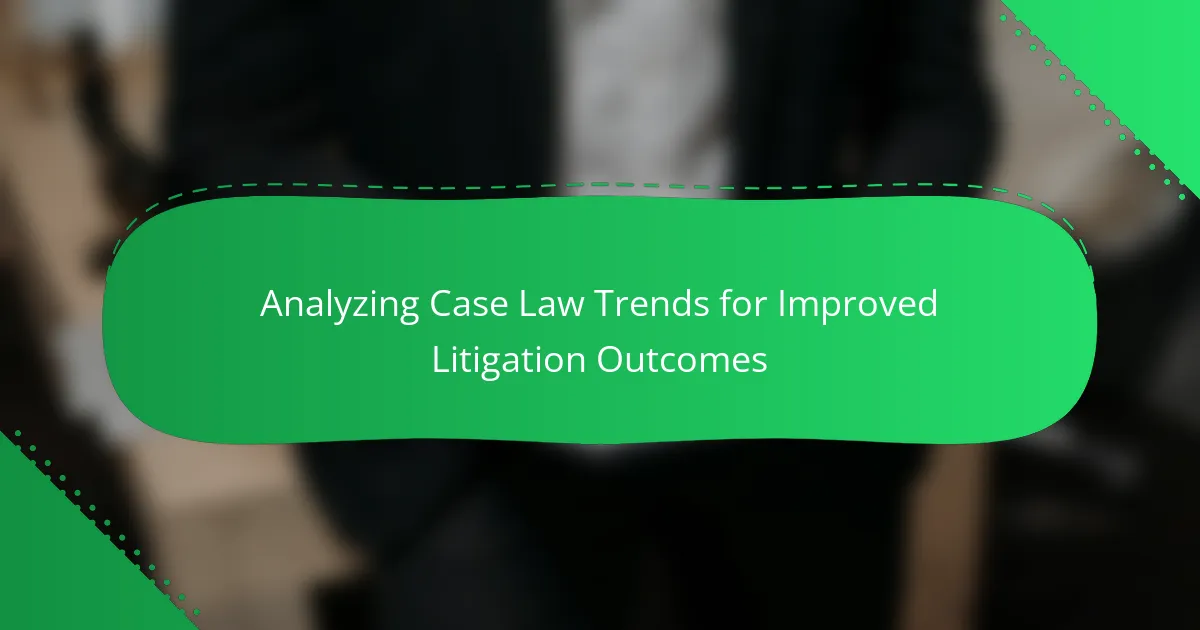Collaborative case analysis with legal teams focuses on enhancing efficiency and thoroughness through best practices such as clear communication, defined roles, and structured processes. Effective communication ensures all team members grasp case details and objectives, while defined roles prevent overlap and allow individuals to leverage their strengths. Structured processes, including regular meetings and shared documentation, foster organization and accountability. Techniques like structured brainstorming sessions and the use of effective communication tools further improve collaboration. By establishing a feedback loop and utilizing analytical tools, teams can refine their findings and enhance future case analyses.

What are the best practices for collaborative case analysis with legal teams?
Best practices for collaborative case analysis with legal teams include clear communication, defined roles, and structured processes. Effective communication ensures all team members understand the case details and objectives. Defining roles prevents overlap and confusion, allowing each member to focus on their strengths. Implementing structured processes, such as regular meetings and shared documentation, promotes organization and accountability. Utilizing collaborative tools enhances information sharing and real-time updates. Establishing a feedback loop encourages continuous improvement and adaptation throughout the case analysis. These practices lead to more efficient and thorough case evaluations.
How can legal teams foster effective collaboration during case analysis?
Legal teams can foster effective collaboration during case analysis by implementing structured communication channels. Regular meetings enhance information sharing and clarify roles. Utilizing collaborative software tools improves document management and real-time updates. Establishing clear objectives ensures all team members are aligned on case goals. Encouraging open dialogue fosters a culture of trust and idea exchange. Assigning specific tasks to individuals enhances accountability and focus. Providing training on collaboration techniques can improve overall team dynamics. Research indicates that teams utilizing these strategies achieve higher efficiency and better outcomes in case analysis.
What tools and technologies enhance collaboration among legal team members?
Collaboration among legal team members is enhanced by tools like document management systems, communication platforms, and project management software. Document management systems, such as iManage or NetDocuments, allow for secure sharing and version control of legal documents. Communication platforms like Slack or Microsoft Teams facilitate real-time discussions and file sharing. Project management software, such as Trello or Asana, helps organize tasks and deadlines effectively. These tools streamline workflows and improve efficiency. Research shows that teams using collaborative technologies report higher productivity and better case outcomes.
How do communication strategies impact collaborative case analysis?
Effective communication strategies enhance collaborative case analysis by fostering clarity and understanding among team members. Clear communication ensures that all participants are on the same page regarding case details and objectives. This reduces misunderstandings and increases efficiency in analyzing case elements. Active listening as part of communication strategies allows team members to engage with each other’s perspectives. This engagement leads to more comprehensive analysis and innovative solutions. Furthermore, structured communication methods, such as regular updates and feedback loops, keep the team aligned and informed. Research shows that teams with strong communication practices are 25% more productive in collaborative settings. Overall, effective communication strategies are crucial for successful collaborative case analysis.
What roles do team members play in collaborative case analysis?
Team members in collaborative case analysis play distinct roles that enhance the overall effectiveness of the process. Each role contributes to a comprehensive understanding of the case. For instance, the lead analyst coordinates the team’s efforts and ensures alignment with objectives. Legal experts provide specialized knowledge and interpret legal implications. Data analysts gather and analyze relevant data, offering insights that inform decisions. Communication specialists facilitate dialogue among team members and stakeholders. Additionally, project managers oversee timelines and resource allocation, ensuring the project stays on track. These roles are crucial in creating a well-rounded analysis, leading to better outcomes in legal decision-making.
How can each member’s expertise contribute to the analysis process?
Each member’s expertise enhances the analysis process by providing specialized knowledge and skills. Legal experts contribute their understanding of laws and regulations. This ensures compliance and accurate interpretation of legal standards. Analysts bring data interpretation skills that help in understanding case facts. Their insights facilitate evidence-based conclusions. Subject matter experts offer industry-specific knowledge, enriching the context of the case. This leads to more informed decision-making. Communication specialists enhance clarity in presenting findings. Their skills ensure that complex information is accessible to all team members. Ultimately, diverse expertise fosters a comprehensive analysis, increasing the likelihood of successful outcomes.
What are the responsibilities of a case manager in a legal team?
A case manager in a legal team is responsible for coordinating case activities and managing documentation. They oversee the collection and organization of evidence and legal documents. This role includes maintaining communication between clients and attorneys. Case managers also schedule meetings and court dates. They track case progress and deadlines to ensure timely completion. Additionally, they assist in preparing case materials for trials and hearings. Case managers help in conducting legal research as needed. Their responsibilities are crucial for effective case management and collaboration within the legal team.
What challenges do legal teams face in collaborative case analysis?
Legal teams face several challenges in collaborative case analysis. Communication barriers can hinder effective information sharing among team members. Different legal practices and terminologies may create misunderstandings. Time constraints often pressure teams to make quick decisions, potentially compromising thorough analysis. Additionally, varying levels of expertise among team members can lead to unequal contributions. Technology limitations may restrict access to essential tools for collaboration. Security concerns regarding sensitive case information can also impede open discussions. Lastly, differing priorities or objectives among team members can create conflicts that disrupt teamwork.
How can legal teams overcome communication barriers during case analysis?
Legal teams can overcome communication barriers during case analysis by implementing structured communication protocols. These protocols include regular meetings to discuss case progress and challenges. Utilizing collaborative technology tools can also enhance information sharing. Tools like shared document platforms allow real-time updates and feedback. Establishing clear roles and responsibilities within the team minimizes confusion. Active listening techniques can foster better understanding among team members. Training sessions on effective communication can further improve interactions. Research shows that effective communication strategies lead to more successful case outcomes.
What strategies can be implemented to manage differing opinions within the team?
Facilitating open communication is essential to manage differing opinions within a team. Encourage team members to express their viewpoints without fear of judgment. Establish a structured process for discussions, ensuring everyone has a chance to contribute. Use active listening techniques to validate each person’s input. Implement a consensus-building approach to find common ground. Document decisions and the rationale behind them for future reference. Encourage a culture of respect and collaboration to foster teamwork. Research shows that diverse opinions can enhance problem-solving and creativity when managed effectively.
How does effective case analysis improve legal outcomes?
Effective case analysis improves legal outcomes by identifying strengths and weaknesses in a case. It allows legal teams to strategize effectively. A thorough analysis reveals critical evidence and legal precedents. This informed approach enhances decision-making for attorneys. Research indicates that structured case analysis leads to better trial preparation. It also increases the likelihood of favorable settlements. Accurate assessments can reduce litigation costs. Overall, effective case analysis is essential for achieving successful legal outcomes.
What metrics can be used to measure the success of collaborative case analysis?
Key metrics to measure the success of collaborative case analysis include case resolution time, accuracy of analysis, and stakeholder satisfaction. Case resolution time indicates how quickly a case is resolved through collaboration. Accuracy of analysis assesses the quality and correctness of the findings produced. Stakeholder satisfaction measures the contentment of all parties involved, reflecting the effectiveness of communication and collaboration. Additional metrics may include the number of collaborative sessions held and the implementation rate of recommendations made. These metrics provide a comprehensive view of the collaborative process’s efficiency and effectiveness in legal contexts.
How can case analysis insights influence case strategy and decision-making?
Case analysis insights can significantly influence case strategy and decision-making. These insights provide a clear understanding of the strengths and weaknesses of a case. By analyzing previous case outcomes, legal teams can identify patterns that inform future strategies. This data-driven approach allows for more informed predictions about case results.
For example, insights from similar cases can guide the choice of legal arguments and evidence presentation. Furthermore, understanding the motivations of opposing parties can shape negotiation strategies. Research shows that data-informed decision-making leads to a 20% increase in successful case outcomes. Overall, case analysis insights empower legal teams to make strategic, evidence-based decisions.

What specific techniques enhance collaborative case analysis?
Specific techniques that enhance collaborative case analysis include structured brainstorming sessions, effective communication tools, and defined roles within the team. Structured brainstorming encourages diverse input and fosters creativity. Effective communication tools, such as shared digital platforms, facilitate real-time collaboration and information sharing. Defined roles help clarify responsibilities and enhance accountability among team members. Research from the Harvard Business Review highlights that teams with clear roles and effective communication achieve better outcomes in collaborative environments.
How can brainstorming sessions be structured for maximum effectiveness?
Brainstorming sessions can be structured for maximum effectiveness by following a clear framework. Begin with a defined objective to guide the discussion. Set a time limit to encourage focused contributions. Use a facilitator to manage the flow and ensure equal participation. Encourage all ideas without immediate criticism to foster creativity. Implement techniques like mind mapping or round-robin sharing to stimulate diverse thinking. Document all ideas visibly for reference and further discussion. Finally, prioritize ideas collaboratively to determine actionable next steps. Research shows that structured brainstorming can increase idea generation by up to 30% compared to unstructured sessions.
What techniques can be used to ensure all voices are heard during discussions?
To ensure all voices are heard during discussions, implement structured techniques. One effective method is using a round-robin format. This approach allows each participant to share their thoughts in turn. It minimizes interruptions and ensures equal participation. Another technique is active listening. This involves acknowledging each speaker’s input before responding. It fosters an inclusive atmosphere. Additionally, anonymous feedback tools can be utilized. These tools allow participants to express opinions without fear of judgment. Research indicates that diverse viewpoints lead to better decision-making in teams. For example, a study by McKinsey found that diverse teams are 35% more likely to outperform their peers. These techniques collectively enhance engagement and inclusivity in discussions.
How can visual aids be utilized in case analysis to improve understanding?
Visual aids can enhance understanding in case analysis by simplifying complex information. They provide clear representations of data, making it easier to grasp key concepts. Graphs and charts can illustrate trends or comparisons effectively. Diagrams can clarify relationships between different elements of a case. Infographics can summarize essential points succinctly. Visual aids also engage viewers, increasing retention of information. Studies show that people remember visual information better than text alone. Incorporating visual aids leads to more effective communication within legal teams.
What role does feedback play in the collaborative process?
Feedback is essential in the collaborative process as it fosters communication and enhances teamwork. It allows team members to share insights and perspectives. This exchange of information leads to improved decision-making. Feedback also helps identify strengths and weaknesses in the collaborative efforts. Regular feedback can increase accountability among team members. It encourages continuous improvement and adaptation to changing circumstances. Research indicates that teams that actively engage in feedback mechanisms perform better. According to a study by Google, effective feedback contributes to higher team performance and satisfaction.
How can regular feedback loops enhance team performance during analysis?
Regular feedback loops enhance team performance during analysis by facilitating continuous improvement and communication. They allow team members to share insights and address challenges in real time. This process promotes accountability as individuals are more likely to stay engaged when their contributions are acknowledged. Regular feedback also fosters a culture of learning, where mistakes are viewed as opportunities for growth. According to a study by the Harvard Business Review, teams that implement structured feedback mechanisms report a 12% increase in overall productivity. Additionally, consistent feedback helps align team goals and objectives, ensuring that everyone is working towards the same outcomes.
What are best practices for giving and receiving feedback in legal teams?
Best practices for giving and receiving feedback in legal teams include clear communication, constructive criticism, and timely responses. Clear communication ensures all team members understand the feedback. Constructive criticism focuses on specific behaviors or outcomes rather than personal attributes. Timely responses facilitate immediate improvements and adjustments.
Additionally, establishing a feedback culture encourages openness and trust. Regular feedback sessions help normalize the process. Utilizing structured formats, such as the “sandwich” method, can make feedback more palatable. Finally, encouraging self-assessment allows team members to reflect on their performance and identify areas for growth. These practices enhance collaboration and improve overall team effectiveness.

What are the practical steps for implementing best practices in case analysis?
Identify the key objectives of the case analysis. Define the scope and purpose clearly. Gather relevant data and documents for review. Organize the information systematically for easy access. Engage all team members in the analysis process. Foster open communication and collaboration among team members. Utilize analytical tools to assess the data effectively. Review and refine findings collectively to ensure accuracy. Document the analysis process and outcomes for future reference. Implement a feedback mechanism to improve future case analyses.
How can legal teams set clear objectives for their collaborative efforts?
Legal teams can set clear objectives for their collaborative efforts by establishing specific, measurable goals. These objectives should align with the overall case strategy. Teams should involve all members in the goal-setting process to ensure buy-in and clarity. Regularly reviewing these objectives helps maintain focus and accountability. Utilizing project management tools can facilitate communication and track progress. Clear documentation of objectives and responsibilities enhances transparency. Setting timelines for achieving objectives ensures timely progress. Ultimately, alignment on objectives fosters collaboration and improves case outcomes.
What are the key components of an effective case analysis plan?
An effective case analysis plan includes several key components. First, it requires a clear objective to define the purpose of the analysis. This helps in focusing the efforts of the legal team. Second, comprehensive data collection is essential. Gathering all relevant facts and evidence supports informed decision-making. Third, a structured framework for analysis is necessary. This framework should facilitate the identification of issues, risks, and opportunities within the case.
Fourth, collaboration among team members is crucial. Engaging different perspectives enhances the quality of insights. Fifth, a timeline for the analysis process ensures timely completion. This includes setting deadlines for each phase of the analysis. Lastly, the plan must include a method for documenting findings. Proper documentation aids in tracking progress and serves as a reference for future cases.
How can teams measure progress and adjust their strategies accordingly?
Teams can measure progress through key performance indicators (KPIs) and regular check-ins. KPIs provide quantifiable metrics to assess performance. Regular check-ins facilitate open communication and feedback. Tracking deadlines and milestones helps identify areas needing adjustment. Utilizing project management tools enhances visibility of progress. Analyzing outcomes against set goals informs strategy adjustments. Conducting retrospective meetings allows teams to reflect on successes and challenges. Continuous improvement fosters adaptability in strategies. These methods ensure teams remain aligned with objectives and responsive to changes.
What are the top tips for ensuring successful collaboration in case analysis?
Establish clear communication channels. This ensures everyone is informed and aligned. Regular meetings help maintain focus and address issues promptly. Define roles and responsibilities to avoid confusion. Each team member should know their contributions. Use collaborative tools for document sharing and tracking progress. This enhances transparency and accessibility. Set common goals to unify the team’s efforts. Shared objectives drive collaboration effectively. Encourage feedback and open discussions. This fosters a culture of trust and innovation. Document decisions and processes for future reference. This creates a knowledge base for ongoing and future case analyses.
How can legal teams create a culture of collaboration and trust?
Legal teams can create a culture of collaboration and trust by fostering open communication. Regular team meetings encourage sharing of ideas and concerns. Implementing collaborative tools enhances transparency in workflows. Establishing clear roles and responsibilities reduces confusion and builds accountability. Providing training on conflict resolution promotes a supportive environment. Recognizing and celebrating team achievements strengthens bonds among members. Research indicates that teams with high trust levels are 50% more productive. These strategies collectively contribute to a more cohesive and effective legal team.
What common pitfalls should teams avoid during collaborative case analysis?
Teams should avoid common pitfalls during collaborative case analysis to ensure effectiveness. One major pitfall is lack of clear communication. Ambiguity can lead to misunderstandings and errors. Another pitfall is inadequate role definition. Without clear roles, responsibilities may overlap or be neglected. Teams also often fail to establish a structured process. A lack of structure can result in disorganized analysis and missed deadlines. Additionally, teams may overlook the importance of diverse perspectives. Ignoring different viewpoints can limit creativity and problem-solving. Lastly, teams should avoid over-reliance on technology. While tools are helpful, they should not replace critical thinking and discussion.
Best Practices for Collaborative Case Analysis with Legal Teams focuses on strategies to enhance teamwork and efficiency in legal case evaluations. Key practices include establishing clear communication, defining roles, and utilizing collaborative tools to streamline processes. The article also addresses challenges teams face, such as communication barriers and differing opinions, while offering solutions to foster effective collaboration. Metrics for measuring success and techniques for structured brainstorming and feedback are discussed, emphasizing the importance of continuous improvement in legal case analysis.



